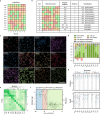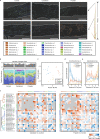Spatial profiling of microbial communities by sequential FISH with error-robust encoding
- PMID: 36932092
- PMCID: PMC10023729
- DOI: 10.1038/s41467-023-37188-3
Spatial profiling of microbial communities by sequential FISH with error-robust encoding
Abstract
Spatial analysis of microbiomes at single cell resolution with high multiplexity and accuracy has remained challenging. Here we present spatial profiling of a microbiome using sequential error-robust fluorescence in situ hybridization (SEER-FISH), a highly multiplexed and accurate imaging method that allows mapping of microbial communities at micron-scale. We show that multiplexity of RNA profiling in microbiomes can be increased significantly by sequential rounds of probe hybridization and dissociation. Combined with error-correction strategies, we demonstrate that SEER-FISH enables accurate taxonomic identification in complex microbial communities. Using microbial communities composed of diverse bacterial taxa isolated from plant rhizospheres, we apply SEER-FISH to quantify the abundance of each taxon and map microbial biogeography on roots. At micron-scale, we identify clustering of microbial cells from multiple species on the rhizoplane. Under treatment of plant metabolites, we find spatial re-organization of microbial colonization along the root and alterations in spatial association among microbial taxa. Taken together, SEER-FISH provides a useful method for profiling the spatial ecology of complex microbial communities in situ.
© 2023. The Author(s).
Conflict of interest statement
The authors declare no competing interests.
Figures






Similar articles
-
Highly multiplexed spatial mapping of microbial communities.Nature. 2020 Dec;588(7839):676-681. doi: 10.1038/s41586-020-2983-4. Epub 2020 Dec 2. Nature. 2020. PMID: 33268897 Free PMC article.
-
Spatial organization of the kelp microbiome at micron scales.Microbiome. 2022 Mar 24;10(1):52. doi: 10.1186/s40168-022-01235-w. Microbiome. 2022. PMID: 35331334 Free PMC article.
-
Primer-free FISH probes from metagenomics/metatranscriptomics data permit the study of uncharacterised taxa in complex microbial communities.NPJ Biofilms Microbiomes. 2019 Jun 25;5(1):17. doi: 10.1038/s41522-019-0090-9. eCollection 2019. NPJ Biofilms Microbiomes. 2019. PMID: 31263569 Free PMC article.
-
Biogeography of the Oral Microbiome: The Site-Specialist Hypothesis.Annu Rev Microbiol. 2019 Sep 8;73:335-358. doi: 10.1146/annurev-micro-090817-062503. Epub 2019 Jun 10. Annu Rev Microbiol. 2019. PMID: 31180804 Free PMC article. Review.
-
Microbial communities and their interactions in biofilm systems: an overview.Water Sci Technol. 2004;49(11-12):327-36. Water Sci Technol. 2004. PMID: 15303758 Review.
Cited by
-
Microbiome in cancer metastasis: biological insights and emerging spatial omics methods.Front Cell Infect Microbiol. 2025 Jun 4;15:1559870. doi: 10.3389/fcimb.2025.1559870. eCollection 2025. Front Cell Infect Microbiol. 2025. PMID: 40535543 Free PMC article. Review.
-
Community standards and future opportunities for synthetic communities in plant-microbiota research.Nat Microbiol. 2024 Nov;9(11):2774-2784. doi: 10.1038/s41564-024-01833-4. Epub 2024 Oct 30. Nat Microbiol. 2024. PMID: 39478084 Review.
-
Insights into the composition and assembly mechanism of microbial communities on intertidal microsand grains.Front Microbiol. 2023 Nov 30;14:1308767. doi: 10.3389/fmicb.2023.1308767. eCollection 2023. Front Microbiol. 2023. PMID: 38098661 Free PMC article.
-
Understanding plant pathogen interactions using spatial and single-cell technologies.Commun Biol. 2023 Aug 4;6(1):814. doi: 10.1038/s42003-023-05156-8. Commun Biol. 2023. PMID: 37542114 Free PMC article. Review.
-
Assembly of functional microbial ecosystems: from molecular circuits to communities.FEMS Microbiol Rev. 2024 Nov 23;48(6):fuae026. doi: 10.1093/femsre/fuae026. FEMS Microbiol Rev. 2024. PMID: 39496507 Free PMC article. Review.
References
-
- Richardson, A.E., Kawasaki, A., Condron, L.M., Ryan, P.R. & Gupta, V.V.S.R. In Rhizosphere Biology: Interactions Between Microbes and Plants. (eds. Gupta, V.V.S.R. & Sharma, A.K.) 109–128 (Springer Singapore, Singapore; 2021).
Publication types
MeSH terms
Substances
LinkOut - more resources
Full Text Sources

